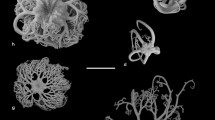Summary
The water vascular system of sea urchins is examined with special reference to the valves positioned between the radial vessel and the ampullae of the tube feet. The lips of the valve protrude into the ampulla. Thus the valve functions mainly like a check valve that allows the unidirectional flow of fluid towards the ampulla. Each ampulla-tube foot compartment acts as a semi-autonomous hydraulic system. The lumina of the ampulla and the tube foot are lined with myoepithelia except for the interconnecting channels that pierce the ambulacral plate. The contraction of the ampulla results in an increasing hydraulic pressure that protrudes the tube foot, provided that the valve is closed. The retraction of the tube foot results in a backflow of fluid independent of the condition of the valve. The lips of the valve are folds of the hydrocoel epithelium. The pore slit lies in the midline. The perradial faces of the lips are covered with the squamous epithelium of the lateral water vessel. The ampullar faces are specialized parts of the ampulla myoepithelium. Turgescent cells which form incompressible cushions take the place of the support cells. The valve myocytes run parallel to the pore slit and form processes that run along the base of the ampulla and the perradial channel up to the podial retractor muscle. The findings lead to the hypothesis of multiple control of the ampulla-tube foot system: (1) The mutual activity of the ampulla and the tube foot is indirectly controlled by the lateral and podial nerves which release transmitter substances that diffuse through the connective tissue up to the muscle layers. (2) A muscle-to-muscle conduction causes the simultaneous contraction of the ampulla or the podial retractor muscles. (3) The valve muscles are directly controlled by the processes of the valve myocytes which make contact with the podial retractor. In extreme conditions a backflow of hydrocoel fluid towards the radial water vessel occurs.
Similar content being viewed by others
References
Bargmann W, Behrens BR (1963) Über den Feinbau des Nervensystems des Seesternes (Asterias rubens L.). II. Mitteilung: Zur Frage des Baues und der Innervation der Ampullen. Z Zellforsch 59:746–770
Bertheussen K, Seljelid R (1978) Echinoid phagocytes in vitro. Exp Cell Res 3:401–412
Cavey JM, Wood RL (1981) Specializations for excitation-contraction coupling in the podial retractor cells of the starfishStylaster forreri. Cell Tissue Res 218:475–485
Cobb JLS (1970) The significance of the radial nerve cords in asteroids and echinoids. Z Zellforsch 108:457–474
Cobb JLS (1987) Neurobiology of the Echinodermata. In: Ali MA (ed) Nervous systems in invertebrates. Plenum Press, New York
Coleman R (1969) Ultrastructure of the tube foot wall of a regular echinoid,Diadema antillarum Philippi. Z Zellforsch 96:162–172
Cuénot L (1891) Etudes morphologiques sur les échinodermes. Arch Biol 11:303–680
Fechter H (1965) Über die Funktion der Madreporenplatte der Echinoidea. Z Vergl Physiol 51:227–257
Fenner DH (1973) The respiratory adaptations of the podia and ampullae of echinoids. Biol Bull 145:323–339
Ferguson JC (1990) Hyperosmotic properties of the fluids of the perivisceral coelom and water vascular system of starfish kept under stabile conditions. Comp Biochem Physiol 95A:245–248
Florey E, Cahill MA (1977) Ultrastructure of the sea urchin tube feet. Evidence for connective tissue involvement in motor control. Cell Tissue Res 177:195–214
Höbaus E (1978) Studies on the phagocytes of regular sea urchins. I. The occurrence of iron containing bodies within the nuclei of phagocytes. Zool Anz (Jena) 200:31–40
Kawaguti S (1964) Electron microscopic structures of the podial wall of an echinoid with special references to the nerve plexus of the muscle. Biol J Okayama Univ 10:1–12
Kawaguti S (1965) Electron microscopy on the ampulla of the echinoid. Biol J Okayama Univ 11:75–86
Märkel K, Röser U (1983) The spine tissues in the echinoidEucidaris tribuloides. Zoomorphology 103:25–41
Märkel K, Röser U (1991) Ultrastructure and organization of the epineural canal and the nerve cord in sea urchins. Zoomorphology 110:267–279
Millot N, Coleman R (1969) The podial pit — a new structure in the echinoidDiadema antillarum Philippi. Z Zellforsch 95:187–197
Nichols D (1959) The histology of the tube feet and clavulae ofEchinocardium cordatum. Quart J Microsc Sci 100:73–87
Nichols D (1961) A comparative histological study of the tube feet of two regular echinoids. Quart J Miscrosc Sci 102:157–180
Nichols D (1966) Functional morphology of the water-vascularsystem. In: Boolootian RA (ed) Physiology of Echinodermata. Interscience Publishers, New York, pp 219–244
Raymond AM (1980) Innervation of echinoid tube feet. In: Jangoux M (ed) Echinoderms:Present and Past. Balkema, Rotterdam, pp 277–283
Rieger RM, Lombardi J (1987) Ultrastructure of coelomic lining in echinoderm podia:significance for concepts in the evolution of muscle and peritoneal cells. Zoomorphology 107:191–208
Smith AB (1978) A functional classification of the coronal pores of regular echinoids. Palaeontology 21:759–789 pls 81–84
Smith AB (1984) Echinoid palaeobiology. George Alien and Unwin, London
Stauber M (1990) Untersuchungen zur Histologie und Ultrastruktur der Echinodermen-Muskeln. Dr-Thesis, Bochum, Germany
Wilkie IC (1984) Variable tensility in echinoderm collagenous tissues: A review. Mar Behav Physiol 11:1–34
Wood RL, Cavey MJ (1981) Ultrastructure of the coelomic lining in the podium of the starfishStylasterias forreri. Cell Tissue Res 218:449–473
Author information
Authors and Affiliations
Rights and permissions
About this article
Cite this article
Märkel, K., Röser, U. Functional anatomy of the valves in the ambulacral system of sea urchins (Echinodermata, Echinoida). Zoomorphology 111, 179–192 (1992). https://doi.org/10.1007/BF01632907
Received:
Issue Date:
DOI: https://doi.org/10.1007/BF01632907




